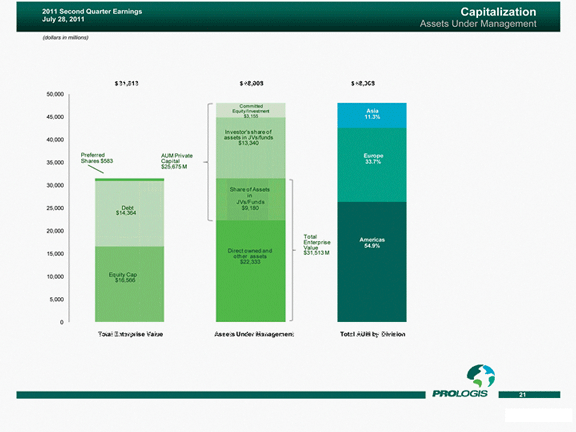| | | | | | | | | | | | | | | | | |
| | | Three Months Ended | | | Six Months Ended | |
| | | June 30, | | | June 30, | |
| | | 2011 | | | 2010 | | | 2011 | | | 2010 | |
Net earnings (loss) |
Net earnings (loss) | | $ | (151,471 | ) | | $ | (23,150 | ) | | $ | (198,087 | ) | | $ | (114,279 | ) |
| | | | | |
Weighted average common shares outstanding — Basic (a) | | | 307,756 | | | | 212,840 | | | | 281,384 | | | | 212,441 | |
| | | | | |
Weighted average common shares outstanding — Diluted (a) | | | 307,756 | | | | 212,840 | | | | 281,384 | | | | 212,441 | |
| | | | | |
| | | | | | | | | | | | | | | | | |
Net earnings (loss) per share — Basic | | $ | (0.49 | ) | | $ | (0.11 | ) | | $ | (0.70 | ) | | $ | (0.54 | ) |
| | | | | |
Net earnings (loss) per share — Diluted | | $ | (0.49 | ) | | $ | (0.11 | ) | | $ | (0.70 | ) | | $ | (0.54 | ) |
| | | | | |
FFO, as defined by Prologis |
| FFO, as defined by Prologis | | $ | 8,195 | | | $ | 67,844 | | | $ | 70,341 | | | $ | 74,961 | |
| Noncontrolling interest attributable to convertible limited partnership units | | | — | | | | — | | | | 136 | | | | — | |
| | | | | |
FFO — Diluted, as defined by Prologis | | $ | 8,195 | | | $ | 67,844 | | | $ | 70,477 | | | $ | 74,961 | |
| | | | | |
| | | | | | | | | | | | | | | | | |
| Weighted average common shares outstanding — Basic (a) | | | 307,756 | | | | 212,840 | | | | 281,384 | | | | 212,441 | |
| Incremental weighted average effect of conversion of limited partnership units | | | — | | | | — | | | | 807 | | | | — | |
| Incremental weighted average effect of stock awards | | | 750 | | | | 1,284 | | | | 709 | | | | 1,359 | |
| | | | | |
Weighted average common shares outstanding — Diluted (a) | | | 308,506 | | | | 214,124 | | | | 282,900 | | | | 213,800 | |
| | | | | |
FFO per share — Diluted, as defined by Prologis | | $ | 0.03 | | | $ | 0.32 | | | $ | 0.25 | | | $ | 0.35 | |
| | | | | |
Core FFO |
| Core FFO | | $ | 109,662 | | | $ | 60,334 | | | $ | 184,069 | | | $ | 112,674 | |
| Noncontrolling interest attributable to convertible limited partnership units | | | 68 | | | | — | | | | 136 | | | | — | |
| | | | | |
Core FFO — Diluted | | $ | 109,730 | | | $ | 60,334 | | | $ | 184,205 | | | $ | 112,674 | |
| | | | | |
| Weighted average common shares outstanding — Basic (a) | | | 307,756 | | | | 212,840 | | | | 281,384 | | | | 212,441 | |
| Incremental weighted average effect of conversion of limited partnership units | | | 1,269 | | | | — | | | | 807 | | | | — | |
| Incremental weighted average effect of stock awards | | | 750 | | | | 1,284 | | | | 709 | | | | 1,359 | |
| | | | | |
Weighted average common shares outstanding — Diluted (a) | | | 309,775 | | | | 214,124 | | | | 282,900 | | | | 213,800 | |
| | | | | |
Core FFO per share — Diluted | | $ | 0.35 | | | $ | 0.28 | | | $ | 0.65 | | | $ | 0.53 | |
| |
| | |
| (a) | | The historical ProLogis shares outstanding have been adjusted by the Merger exchange ratio of 0.4464. These amounts include the assumed issuance of 254.8 million shares as of the Merger date and the issuance of 34.5 million shares in connection with the June equity offering. We received net proceeds from the equity offering of $1.1 billion, which were used to repay outstanding borrowings on the bridge facility and on credit facilities. |
Core EBITDA, As Adjusted.We use Core EBITDA, as adjusted to measure both our operating performance and liquidity. We calculate Core EBITDA, as adjusted beginning with consolidated net earnings/loss and removing the affect of interest, income taxes, depreciation and amortization, impairment charges, gains or losses from the acquisition or disposition of investments in real estate, gains or losses on early extinguishment of debt and derivative contracts (including cash charges), similar adjustments we make to our Core FFO (see definition below), and other non-cash charges (such as stock based compensation amortization and unrealized gains or losses on foreign currency and derivative activity), including our share of these items (other than interest and current income taxes) from unconsolidated investees.
We consider Core EBITDA, as adjusted to provide investors relevant and useful information because it permits investors to view income from operations on an unleveraged basis before the effects of income tax, non-cash depreciation and amortization expense and other items (including stock-based compensation amortization and certain unrealized gains and losses), gains or losses from the acquisition or disposition of investments in real estate, items that affect comparability, and other significant non-cash items. In 2011, we adjusted Core EBITDA to include a proforma adjustment to reflect a full period of NOI on the operating properties we acquired through the Merger and PEPR acquisition and to exclude Merger, Acquisition and Other Integration Expenses and costs associated with the hurricane and tsunami that occurred in first quarter 2011 in Japan. By excluding interest expense, adjusted EBITDA allows investors to measure our operating performance independent of our capital structure and indebtedness and, therefore, allows for a
more meaningful comparison of our operating performance to that of other companies, both in the real estate industry and in other industries. Gains and losses on the early extinguishment of debt and derivatives contracts generally included the costs of repurchasing debt securities. Although difficult to predict, these items may be recurring given the uncertainty of the current economic climate and its adverse effects on the real estate and financial markets. While not infrequent or unusual in nature, these items result from market fluctuations that can have inconsistent effects on our results of operations. The economics underlying these items reflect market and financing conditions in the short-term but can obscure our performance and the value of our long-term investment decisions and strategies.
As a liquidity measure, we believe that Core EBITDA, as adjusted helps investors to analyze our ability to meet interest payment obligations and to make quarterly preferred share dividends. We believe that investors should consider Core EBITDA, as adjusted in conjunction with net income (the primary measure of our performance) and the other required Generally Accepted Accounting Principles (“GAAP”) measures of our performance and liquidity, to improve their understanding of our operating results and liquidity, and to make more meaningful comparisons of our performance against other companies. By using Core EBITDA, as adjusted, an investor is assessing the earnings generated by our operations, but not taking into account the eliminated expenses or gains incurred in connection with such operations. As a result, core EBITDA, as adjusted has limitations as an analytical tool and should be used in conjunction with our required GAAP presentations. Core EBITDA, as adjusted does not reflect our historical cash expenditures or future cash requirements for working capital, capital expenditures distribution requirements or contractual commitments. Core EBITDA, as adjusted also does not reflect the cash required to make interest and principal payments on our outstanding debt.
While Core EBITDA, as adjusted is a relevant and widely used measure of operating performance and liquidity, it does not represent net income or cash flow from operations as defined by GAAP and it should not be considered as an alternative to those indicators in evaluating operating performance or liquidity. Further, our computation of Core EBITDA, as adjusted may not be comparable to EBITDA reported by other companies. We compensate for the limitations of Core EBITDA, as adjusted by providing investors with financial statements prepared according to GAAP, along with this detailed discussion of Core EBITDA, as adjusted and a reconciliation of Core EBITDA, as adjusted to consolidated net earnings (loss), a GAAP measurement.
Estimated Investment Capacityis our estimate of the gross real estate, which could be acquired through the use of the equity commitments from our property fund or co-investment venture partners, plus our funding obligations and estimated debt capitalization.
FFO; FFO, as defined by Prologis; FFO, excluding significant non-cash items; Core FFO (collectively referred to as “FFO”).FFO is a non-GAAP measure that is commonly used in the real estate industry. The most directly comparable GAAP measure to FFO is net earnings. Although the National Association of Real Estate Investment Trusts (“NAREIT”) has published a definition of FFO, modifications to the NAREIT calculation of FFO are common among REITs, as companies seek to provide financial measures that meaningfully reflect their business.
FFO is not meant to represent a comprehensive system of financial reporting and does not present, nor do we intend it to present, a complete picture of our financial condition and operating performance. We believe net earnings computed under GAAP remains the primary measure of performance and that FFO is only meaningful when it is used in conjunction with net earnings computed under GAAP. Further, we believe our consolidated financial statements, prepared in accordance with GAAP, provide the most meaningful picture of our financial condition and our operating performance.





















































